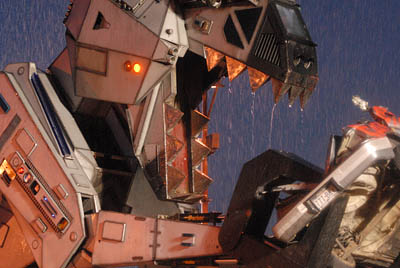

Robosaurus Working - 1990 to 2008


Robosaurus
RETIRED -
2008 to ?
Museum Display Samples
(Click on any photo below to see a larger
version)
SAMPLE LETTER SENT TO THE MUSEUMS:
Dear Board Members of the Museum of Modern Art,
Happy Holidays!
As you may or may not have heard, one of the greatest pieces of postmodern art, "Robosaurus," is about to be sold next month at the Barrett-Jackson Collector Car Auction in Scottsdale, AZ. I represent Doug Malewicki, the designer of the machine. It is Doug's wish that his Robosaurus go to a museum and not be repurposed by a private entity or a corporation like NASCAR.
The Robosaurus, the one and only machine of its kind in the world, is a 42 foot tall car-crushing robot monster, and it is a unique and powerful vision that is a testament to the imagination of Man. Millions have been thrilled by this machine, which was not designed by a huge company, but by one man, artist and inventor Doug Malewicki. The machine represents our fears of technology, our obsession with cars and oil, and Man vs. Nature.
Robosaurus blends form and function together, allowing only a few operators to easily transform a street-legal semi truck into the four-story beast, and one or two pilots in the head to control the arms, movement, and flames.
Since its introduction in 1990, the machine has become a pop culture icon. It was parodied in a classic episode of The Simpsons, and has been featured in countless films, TV shows, and commercials. Just this year Robo appeared in a popular Toyota Tacoma commercial and performed at the Transformers movie premiere in Austin, TX. Robosaurus is, however, getting older and the owners are ready to retire from car shows. Robosaurus needs a permanent home at a museum, where it can be admired as the art it was intended to be.
Please consider bidding on this machine. The MoMA is one of the greatest museums in the world, and Robosaurus would be the perfect acquisition.
Sincerely,
Joey V.
VP Marketing
AeroVisions, Inc.
List of Museums we sent the Robosaurus letter to:
MoMA, New York California Science Center London Science Museum San Francisco MoMA
Museum of Science and Industry (Chicago) Boston's Museum of Science Smithsonian National Air and Space Museum Associação Portuguesa de Museologia - Portugal Japanese Association of Museums Smithsonian Institute Asociación Española de Museólogos, Spain Japanese Science Foundation (involved with several smaller museums) Cooper Hewitt National Design Museum, NY Associazione Nazionale Musei Scientifici, - Italy National Science Museum, Tokyo Museums Association, UK, Chinese Society of Museums Miraikan - Japan's National Museum of Emerging Science and Innovation Museum Association of Israel Bien Cultural – Brazil museum society Museum of Discovery and Science, FL Guggenheim, NY Guggenheim Las Vegas Guggenheim Foundation (including
the new one being built in Abu Ghabi)Denver museum of nature and science San Diego Air and Space Museum Venetian Hotel/Casino, Las Vegas The Franklin Institute Science Museum (Philadelphia) J. Paul Getty Museum, L.A.
I still love the idea of programming Robo to move very, very sloooww. So slow that you really couldn't stand there and see anything happening. But, when you come out of the museum later on, you would glance over and check to confirm that YES the eyelid is opening; YES its' head is starting to lift up to look at something; and YES the right hand claw definitely has closed its grasp ever so slightly. Come back in a week and see how the "art" has moved. Come back in a month, take some photos and ponder if this is the world's slowest monster attack or what? Something like this could be programmed randomly so it wouldn't repeat the same motion for a hundred years!
To the casual observer, the Robosaurus would appear static - like the typical rigid sculpture, but to the returning critic it would be infinitely more intriguing! It all gets back to "What is art?" and would Robosaurus attract many more children and young adults to the museum?